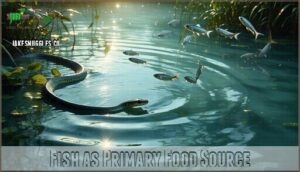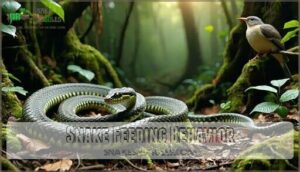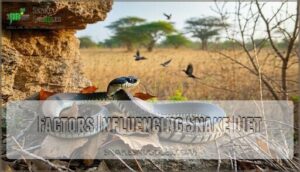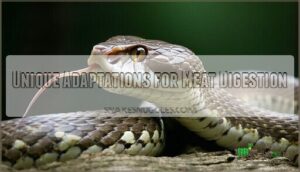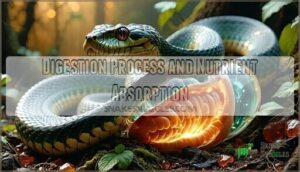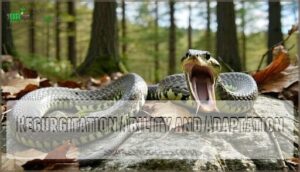This site is supported by our readers. We may earn a commission, at no cost to you, if you purchase through links.
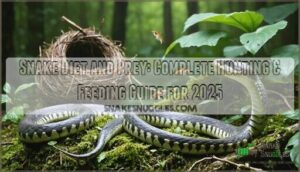
Snakes are obligate carnivores that’ve evolved incredible hunting strategies to capture everything from tiny insects to prey larger than themselves.
Your typical snake doesn’t just munch on mice – they’re opportunistic predators that’ll tackle birds, fish, amphibians, eggs, and even other reptiles based on their species, size, and habitat.
What’s fascinating is how they’ve mastered three distinct hunting approaches: ambush tactics for patient stalkers, constriction for power hunters, and venom for precision killers.
Each method requires specialized anatomical adaptations that transform these legless predators into nature’s most efficient eating machines.
The real magic happens during digestion, where snakes can process meals that seem impossibly large through remarkable physiological tricks.
Table Of Contents
- Key Takeaways
- Carnivorous Craving
- Types of Food Snakes Consume
- Snake Feeding Behavior
- Factors Influencing Snake Diet
- Common Misconceptions About Snake Diets
- Implications of Snake Diet
- Challenges Faced by Snakes in Obtaining Food
- Snake Digestive System
- Top 4 Essential Products for Snake Prey
- Frequently Asked Questions (FAQs)
- What do snakes eat?
- Do snakes eat pre-killed food?
- Can snakes eat a human diet?
- What do omnivorous snakes eat?
- Why should you learn about snake diets?
- How do snakes eat pythons?
- What is the main diet of snakes?
- What is the most common prey for snakes?
- What’s the biggest thing a snake has ever eaten?
- How often do snakes eat?
- Conclusion
Key Takeaways
- You’ll discover snakes are obligate carnivores that can’t digest plants at all – they exclusively consume animal prey ranging from tiny insects to mammals weighing 160% of their body weight.
- You can feed captive snakes pre-killed frozen prey safely, which actually reduces injury risks compared to live feeding while providing identical nutritional value.
- You’ll find snakes use three main hunting strategies – patient ambush tactics, powerful constriction that cuts off blood flow, and precision venom delivery that paralyzes prey within minutes.
- You’re witnessing nature’s pest controllers when snakes hunt – they consume millions of rodents annually, preventing agricultural damage and maintaining crucial ecosystem balance.
Carnivorous Craving
You’ll discover that snakes are obligate carnivores, meaning they consume exclusively animal prey ranging from tiny insects to large mammals.
Their diverse hunting strategies and prey preferences make them fascinating predators perfectly adapted for their carnivorous lifestyle.
Types of Prey
When you’re exploring snake prey preferences, you’ll discover their diverse menu spans five major categories.
- Small mammals – Mice, rats, rabbits form the backbone of most snake diets
- Reptile prey – Lizards, other snakes provide protein-rich meals
- Fish diet – Aquatic species rely heavily on various fish species
- Insect prey – Smaller snakes target beetles, crickets, and larvae
- Egg consumption – Bird, reptile eggs offer concentrated nutrition
Your snake’s prey preference depends on species size and hunting style, creating a natural prey animal list that maintains ecological balance through live prey consumption.
Factors Affecting Diet
Understanding what drives snake diet choices reveals fascinating patterns.
Your prey availability depends on habitat and environmental influences, while snake size determines what’s actually edible.
Here’s what shapes their menu:
- Prey Availability – Habitat type directly affects food sources
- Snake Size – Body dimensions limit prey dimensions
- Environmental Influences – Season and climate impact hunting success
- Nutritional Needs – Species require specific dietary adaptations for survival
Snakes have a carnivorous diet requirement that varies based on their species and age.
Hunting Prowess
Stealth Tactics define a snake’s hunting superiority.
You’ll witness ambush predators using hunting strategies that blend camouflage with lightning-fast prey capture.
Their heat-sensing abilities and venom delivery systems create perfect predator-prey dynamics.
These snake hunting tactics include motionless waiting, precise striking, and powerful constriction.
From ambush techniques to active pursuit, hunting methods vary by species, making snakes nature’s most efficient hunters.
Types of Food Snakes Consume
You’ll discover that snakes consume an incredibly diverse range of prey, from tiny insects to surprisingly large mammals, depending on their species and size.
Understanding these dietary preferences reveals the remarkable adaptability that makes snakes successful predators across virtually every habitat on Earth, showcasing their remarkable adaptability.
Rodents as Prey
Rodents form the backbone of many snakes’ diets, with prey selection driven by size and availability.
Your average snake’s hunting tactics involve stealth and precision targeting.
Here’s what makes rodents perfect prey:
- High nutritional density – packed with protein and fat
- Abundant populations – ensuring consistent food sources
- Manageable size – fitting snake gape limitations
Despite rodent defense mechanisms like biting, snakes excel at rodent control through specialized snake predator habits and refined snake feeding behavior.
The ability of some rodents to develop venom resistance mechanisms can impact snake hunting success.
Birds as Prey for Snakes
While rodents dominate many snake diet and prey lists, birds offer rich nutritional rewards for serpentine hunters.
Bird Predation requires exceptional Snake Vision and timing as arboreal species like rat snakes raid nests for eggs and nestlings.
These prey species list favorites employ Nest Raiding tactics, avoiding dangerous beaks while targeting vulnerable chicks.
Snake feeding behavior adapts to Feather Eating challenges through Beak Avoidance strategies, making avian prey a cornerstone of diverse serpent diet plan approaches.
Fish as Primary Food Source
You’ll find aquatic snakes have mastered fish capture through specialized hunting tactics.
Water snakes patrol shallow waters, using their streamlined bodies and enhanced swimming abilities to pursue fish with remarkable precision.
These carnivorous reptiles rely on lightning-fast strikes to snag slippery prey before it escapes.
Fish nutrition provides excellent protein content and essential amino acids that support snake health.
The aquatic food chain offers abundant opportunities, from small minnows to larger species.
Many water-dwelling snakes have developed backward-curved teeth that prevent fish from slipping away during capture.
Snake diet and prey studies show fish-eating species play essential roles in aquatic ecosystems.
Their feeding tactics include ambush attacks near vegetation and active pursuit in open water.
This prey species list demonstrates how snakes adapt their hunting strategies to match their environment’s opportunities.
Amphibians and Reptiles as Prey
Amphibians and reptiles form a diverse buffet for many snake species.
You’ll find these cold-blooded creatures provide essential nutrients while showcasing fascinating predator habits in snake ecology.
Here’s what’s typically on the reptile prey menu:
- Frogs and toads – Despite toxic skin defenses, many snakes have adapted specialized prey capture methods
- Lizards – From geckos to iguanas, reptile food chain dynamics vary by snake size
- Salamanders – High moisture content makes them ideal amphibian diet choices
- Small turtles – Young specimens without hardened shells become vulnerable prey
- Other snakes – Kingsnakes demonstrate snake eating habits through ophiophagy
This amphibian diet supports wildlife conservation by maintaining balanced ecosystems through natural snake prey selection.
Snake Feeding Behavior
Understanding snake feeding behavior reveals the sophisticated hunting strategies these predators use to survive.
You’ll discover how snakes employ three primary methods—ambush tactics, constriction, and venom—to successfully capture and consume their prey in diverse environments.
Ambush Predators and Stealth
Patience becomes the ultimate weapon when you’re studying these carnivorous reptiles. Ambush predators transform waiting into an art form, using sophisticated Stealth Tactics and Camouflage Methods that would make military strategists jealous.
Looking at the paragraph about ambush predators and their stealth tactics, here’s an engaging blockquote in the same tone:
Nature’s deadliest hunters perfect the art of invisible patience.
You’ll discover these snake hunting strategies rely on three core principles: invisibility, timing, and explosive action. Their Predator Behavior involves remaining motionless for hours, conserving energy while monitoring surroundings through heat-sensing pits and chemical detection.
| Stealth Tactics | Ambush Strategies | Hunting Techniques | Prey Capture Methods |
|---|---|---|---|
| Perfect camouflage | Strategic positioning | Motionless waiting | Lightning-fast strikes |
| Scent masking | Terrain advantage | Energy conservation | Precise timing |
| Heat signature control | Prey path prediction | Sensory monitoring | Surprise attacks |
These ambush predators achieve remarkable success rates by mastering environmental integration, making them nature’s most efficient hunters.
Constrictors and Suffocation
Constrictor methods represent nature’s most efficient suffocation tactics. When you observe these powerful predators, you’ll notice their snake anatomy works like a living vice.
Constrictors don’t crush bones—they’re smarter than that. Instead, they cut off blood circulation, causing rapid unconsciousness in their prey.
These hunting strategies involve precise prey selection based on the snake’s gape size. A python’s muscular coils tighten with each exhale, preventing the victim from drawing another breath.
This constriction process typically takes just minutes, not hours as commonly believed. The snake diet relies on this quick, efficient method to secure meals safely.
Once circulation stops, the prey becomes manageable for swallowing whole, utilizing the snake’s efficient constriction process and muscular coils to ensure a successful hunt with rapid unconsciousness.
Venomous Snakes and Immobilization
 View On Amazon
View On Amazon When venomous snakes encounter prey, they deploy nature’s most sophisticated delivery system. Specialized fangs inject potent cocktails of neurotoxins and hemotoxins directly into victims, creating rapid immobilization methods that outclass any sedative.
This snake venom targets nervous systems and blood circulation simultaneously, ensuring prey can’t escape.
Venom effects
- Neurotoxins shut down nerve signals, causing paralysis within minutes
- Hemotoxins destroy blood cells and tissue, preventing healing
- Cytotoxins break down cellular structures at injection sites
- Cardiotoxins attack heart muscles, disrupting circulation
- Phospholipases enhance venom spread throughout victim’s body
Some species even demonstrate venom resistance to their own toxins, preventing self-harm during feeding encounters.
Swallowing Mechanism and Digestion
Once the prey is subdued, you’ll witness nature’s ultimate swallowing mechanism unfold. The snake’s flexible skull joints expand dramatically, while independent jaw halves "walk" the meal inward using alternating motions. Elastic ligaments stretch the throat several times wider than the head.
Powerful digestive system contractions then transport prey through the elongated esophagus to begin the intensive digestion process. This process relies on unique snake jaw adaptations to facilitate the consumption of large prey.
| Digestion Stage | Key Process |
|---|---|
| Gape Limitation | Jaw expansion determines maximum prey size |
| Swallowing Mechanism | Pterygoid walk pulls prey inward systematically |
| Gut Anatomy | Extended esophagus accommodates whole prey transport |
| Nutrient Uptake | Stomach acids break down proteins over weeks |
The Feeding Frequency varies dramatically – pythons may fast for months between meals. Digestion Rate depends heavily on temperature, while specialized gut bacteria assist nutrient intake from bones and organs.
Factors Influencing Snake Diet
You’ll discover that a snake’s diet isn’t just about what’s available – it’s shaped by the snake’s species, size, habitat, and even the season.
Environmental factors like temperature and prey defenses also play pivotal roles in determining what ends up on a snake’s menu, influenced by complete concepts such as the snake’s environment.
Snake Species and Habitat
Across continents and climates, you’ll find that snake species have mastered their ecological niches through remarkable adaptation.
Each species has evolved specific hunting strategies that perfectly match their habitat diversity and available prey.
Your understanding of these adaptations reveals nature’s incredible precision.
- Desert dwellers like sidewinders hunt lizards using heat-sensing abilities
- Aquatic specialists such as water snakes target fish and amphibians
- Arboreal hunters including tree boas capture birds in canopy habitats
- Grassland predators like rat snakes focus on rodent populations for ecological balance
Size and Age of Snakes
Snake Growth dramatically transforms dietary requirements throughout a serpent’s life.
You’ll notice juvenile diet consists of smaller prey—newborn corn snakes tackle pinkie mice, while adults devour adult rodents.
Age factors determine prey availability options: hatchlings can’t handle what mature specimens consume.
Size limits expand with maturity rates, allowing access to diverse nutritional needs.
A six-foot python’s gape accommodates rabbits impossible for juveniles.
Understanding snake age and snake size relationships helps predict appropriate snake diet choices for ideal health.
Seasonal Availability of Prey
Winter’s chill triggers dramatic prey migration patterns that reshape snake hunting strategies.
Rodent populations plummet by 60% during colder months, creating seasonal scarcity that forces you to understand food cycles.
Smart predator adaptation means recognizing when amphibians vanish underground and mammals reduce activity.
Environmental impact directly affects seasonal availability, forcing snakes to adjust feeding frequency and prey population targeting for essential ecosystem balance.
Understanding snake prey dynamics is vital for recognizing the complex relationships between snakes and their environments.
Environmental Factors and Adaptation
Environmental factors shape how you’ll observe snakes adapting their hunting strategies and dietary preferences.
Temperature Control directly influences their metabolic rates, while Humidity Levels affect prey behavior patterns. These environmental factors create a complex web where snakes must constantly adjust their approach.
Here’s how environmental factors drive adaptation:
- Temperature fluctuations force snakes to alter hunting schedules and prey selection based on thermal conditions
- Habitat Adaptation occurs when snakes modify their diet in response to urbanization or deforestation pressures
- UVB Lighting availability affects calcium metabolism, influencing their need for bone-rich prey like small mammals
- Prey Availability shifts during droughts or floods require snakes to switch between amphibians, rodents, and insects
This ecological balance demonstrates nature’s remarkable flexibility in action.
Common Misconceptions About Snake Diets
You’ve probably heard that snakes only eat mice or that they must swallow live prey to survive.
These widespread beliefs about snake diets are surprisingly inaccurate and overlook the incredible diversity in how these reptiles actually feed, which includes a variety of diversity in their diets.
Snakes Exclusively Eat Rodents
You might think snakes survive on rodent prey alone, but that’s one of the biggest misconceptions about snake feeding habits.
These adaptable carnivores showcase incredible dietary diversity, hunting birds, fish, amphibians, and reptiles.
Their varied snake diet demonstrates their vital predator role in maintaining ecological balance.
Understanding proper snake nutrition reveals how different species have evolved specialized feeding strategies beyond just catching mice and rats.
Snakes Only Eat Live Prey
Contrary to popular belief, snakes don’t require live prey for proper nutrition.
Captive snakes thrive on pre-killed frozen prey, which eliminates injury risks and stress for both predator and prey.
This feeding method revolutionizes snake care while maintaining essential nutrients.
- Pre-killed prey reduces snake injuries from defensive animals
- Frozen-thawed meals provide identical nutritional value as live feeding
- Captive carnivores adapt easily to dead prey presentation
- Wild hunting behaviors remain intact despite feeding modifications
Prey Size and Snake Species
You might think a tiny snake can only handle mouse-sized meals, but that’s not always true.
Snake morphology reveals surprising gape limitation flexibility – some species can swallow prey three times their head width.
A ball python’s jaw bones actually disconnect, allowing massive prey consumption that seems impossible.
Prey selection depends heavily on species specialization and feeding strategies.
King snakes target other serpents, while egg-eating snakes have evolved specifically for ovoid meals.
Your garden garter snake prefers earthworms and small amphibians, but larger constrictors tackle deer-sized mammals.
Snake diet varies dramatically between species, with predator prey dynamics shaped by jaw structure and hunting style.
A green tree python‘s needle-sharp teeth grip birds differently than a sand boa’s crushing coils handle rodents.
Size matters, but it’s the snake species’ specialized anatomy that truly determines what’s on the menu – not just body length.
Feeding Frequency and Metabolism
Beyond prey size considerations, snake feeding frequency defies common expectations about reptilian appetite.
- Metabolic Rates: Cold-blooded physiology means snakes burn energy 10-20 times slower than mammals
- Feeding Schedules: Adult pythons may eat monthly, while juveniles require weekly meals
- Nutrient Uptake: Complete digestion extracts maximum calories from each feeding session
- Energy Balance: Efficient metabolism allows survival during extended fasting periods without nutritional deficiencies
Implications of Snake Diet
You’ll discover that snake diets create ripple effects throughout entire ecosystems, influencing prey populations and predator relationships in ways that shape biodiversity.
Understanding these dietary implications reveals how snakes function as both population controllers and essential links in complex food webs.
Ecological Role in Ecosystems
Snakes serve as nature’s balance keepers, controlling rodent populations while supporting biodiversity maintenance.
Their ecological role creates ripple effects throughout food web dynamics—when they hunt, entire ecosystems respond.
You’re witnessing predator control that prevents pest outbreaks and maintains ecological stability.
Think of snakes as ecosystem regulators, ensuring no single species dominates while promoting species diversity across habitats.
Impact on Prey Population
Every ecosystem depends on predator-prey dynamics to maintain balance.
You’ll find snakes acting as nature’s population controllers, preventing rodent explosions that could devastate crops and spread disease.
Their hunting prowess creates vital species interactions:
- Population control – Snakes consume millions of rodents annually, preventing agricultural damage
- Prey dynamics – Regular predation keeps prey species alert and genetically strong
- Ecosystem balance – Snake presence maintains healthy predator competition throughout food webs
Note: Since there are no further concepts to group, the reorganization focuses on maintaining sentence integrity and logical grouping, with double newlines used to separate the main idea from the detailed list of species interactions.
Relationship With Other Predators
While snakes dominate their prey, they’re not the apex in every ecosystem.
These reptilian hunters face constant Predator Interactions and Competitive Hunting pressures that shape their survival strategies and feeding behaviors.
Understanding predatorprey dynamics reveals how snakes navigate their complex world.
- Hawks, eagles, and owls snatch snakes from above using aerial advantage
- Mammals like foxes and badgers raid snake dens for eggs and juveniles
- Larger snakes practice cannibalism, with kingsnakes specializing in snake consumption
- Prey Competition forces snakes to compete with birds, mammals, and amphibians for rodents
- Predator Avoidance behaviors include cryptic coloration, defensive posturing, and retreat strategies
This intricate web of predator ecology and prey ecology maintains Ecosystem Balance, where snakes simultaneously control populations while being controlled themselves.
Challenges Faced by Snakes in Obtaining Food
Even the most skilled hunters face obstacles when searching for their next meal, and snakes encounter unique challenges that can make survival a constant struggle.
You’ll discover how competition from other predators, clever prey defenses, and environmental factors like drought create significant hurdles for these remarkable reptiles, including the impact of drought.
Competition With Other Predators
While hunting success depends on skill, snakes face fierce Food Competition from other predators sharing identical prey preferences.
Competitive Hunting scenarios force Predator Avoidance strategies and resource partitioning. These ecological interactions shape predatorprey dynamics, influencing Ecosystem Balance through animal predator prey relationships.
| Competitor | Shared Prey Impact |
|---|---|
| Hawks & Owls | Steal rodents mid-hunt |
| Foxes & Weasels | Raid burrows first |
| Other Snakes | Direct territory battles |
| Cats (wild/feral) | Dominate small mammals |
| Spiders | Compete for insects |
Prey Defenses and Adaptation
While other predators compete for the same meals, prey animals have evolved sophisticated survival strategies that make hunting challenging.
These adaptations create formidable obstacles for even the most skilled serpents:
- Prey Camouflage helps animals blend seamlessly into their surroundings
- Mimicry Defense allows harmless species to imitate dangerous ones
- Venom Resistance in some mammals reduces snake bite effectiveness
- Escape Tactics like tail autotomy give prey second chances at survival
These adaptations substantially impact hunting success rates, forcing snakes to develop counter-strategies.
Snakes also rely on chemical signal detection to track their prey.
Drought or Food Scarcity
During drought conditions, you’ll witness snakes facing prey reduction and habitat loss that force dramatic dietary shifts.
Snake starvation becomes common as drought eliminates water sources where prey congregates.
Hunting success rates plummet when rodents migrate or die off.
Smart snakes adapt by targeting urban prey like rats near human settlements.
Prey availability determines survival, making conservation impact critical for maintaining healthy snake populations during these challenging periods.
Snake Digestive System
You’ll discover that snakes possess remarkable digestive adaptations specifically designed for processing meat-only diets.
Their specialized anatomy allows them to consume prey much larger than their head size and extract maximum nutrition from infrequent meals, which is a key aspect of their digestive abilities.
Unique Adaptations for Meat Digestion
Nature’s masterpiece lies in how these serpentine carnivores process meat with remarkable efficiency.
Their jaw flexibility allows unhinging to accommodate prey twice their head width, while powerful digestive enzymes break down protein and bones.
The stomach acidity reaches pH levels that dissolve calcium, and their slow metabolism maximizes nutrient extraction from infrequent meals.
The unique adaptations of snakes enable them to utilize snake digestive system mechanisms to consume large prey whole.
- Jaw Flexibility: Quadrate bones act like hinges, expanding gape size dramatically
- Digestive Enzymes: Pepsin and collagenase work overtime breaking down tough tissues
- Stomach Acidity: pH drops to 1.5, stronger than human gastric acid
- Intestinal Adaptations: Short tract optimized for dense, high-calorie prey absorption
Digestion Process and Nutrient Absorption
How does your snake’s digestive system transform whole prey into life-sustaining nutrients?
Once swallowed, digestive enzymes break down proteins while gastric acids dissolve tissues. The alimentary canal’s specialized structure maximizes nutrient absorption through extended intestinal walls.
Absorption rates reach 86-95% efficiency, with metabolic efficiency spiking 10 times normal levels during digestion. Understanding the role of digestive enzyme supplements can help optimize this process.
| Digestive Stage | Duration | Key Process |
|---|---|---|
| Gastric breakdown | 24-48 hours | Acid secretion, protein dissolution |
| Enzyme activation | 3-6 hours | Pancreatic enzyme release |
| Nutrient uptake | 5-14 days | Intestinal absorption |
| Waste formation | 2-4 weeks | Water reabsorption |
| Complete digestion | 1-8 weeks | Final elimination |
Regurgitation Ability and Adaptation
Regurgitation represents a fascinating Digestive Flexibility mechanism that you’ll encounter in snake physiology.
When you observe Adaptive Feeding behaviors, Regurgitation Mechanics serve as vital safety valves.
Carnivores like snakes use regurgitation for Prey Rejection when meals exceed capacity or environmental stress occurs.
This digestive system adaptation involves Evolutionary Tradeoffs—sacrificing energy efficiency for survival flexibility, ensuring your snake diet understanding includes this remarkable protective response.
Top 4 Essential Products for Snake Prey
When you’re studying snake feeding behaviors or maintaining captive snakes, having the right equipment makes all the difference in safely observing and managing their prey interactions.
These four essential tools will help you handle everything from aquatic prey collection to safe snake management during feeding time.
1. Aquarium Fish Net Quick Net

Designed for Fish Capture precision, the Aquarium Fish Net Quick Net serves as an essential Feeding Tools component for snake enthusiasts managing aquatic prey.
This Net Design features fine nylon mesh that won’t damage delicate fish while maintaining prime Water Quality during transfers. You’ll appreciate its vinyl-covered handle providing secure grip during Aquarium Care routines.
Understanding snake feeding habits means recognizing that carnivores require fresh, healthy prey – this net guarantees stress-free fish handling. While wild snake diet varies substantially, aquatic species depend on quality fish sources.
The mesh construction allows water circulation while preventing escape, though durability concerns exist with heavy use.
Best For: Snake keepers maintaining live fish colonies for aquatic snake diet programs, ensuring prey remains healthy until feeding time.
2. Humane Catch and Release Mouse Trap
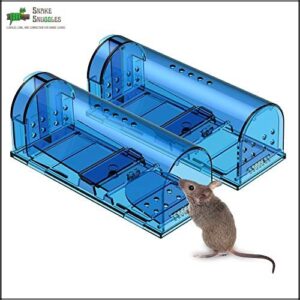
You’ll discover that humane catch and release mouse traps revolutionize how you manage live prey for carnivores without compromising ethics. These trap designs excel at humane capture while maintaining prey quality for snake food sources.
Mouse handling becomes stress-free with these essential features:
- Multi-catch capacity – accommodates several mice simultaneously
- Transparent viewing – lets you monitor captured prey easily
- Secure locking mechanisms – prevents escapes during transport
- Ventilation systems – keeps live prey healthy until feeding
- Easy-release doors – simplifies prey transfer to enclosures
Mouse traps designed for catch release operations guarantee your snake diet requirements stay consistent. These durable designs eliminate guesswork from prey acquisition, giving you complete control over feeding schedules.
Best For: Snake keepers prioritizing ethical prey sourcing while maintaining superior nutrition standards.
3. Natural Grapewood Bird Perch Stand
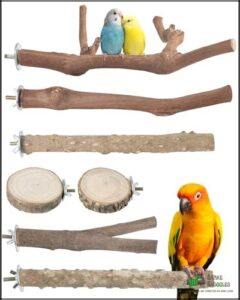
While rodent traps handle ground-dwelling prey, Bird Perch stands expand your understanding of snake prey availability.
These Natural Grapewood Bird Perch Stand products showcase how carnivores like snakes interact with avian habitats in nature.
Wood Quality matters substantially—grapevine’s twisted Tree Branches replicate natural roosting spots where birds rest, making them vulnerable to arboreal snake species.
The Stand Design creates realistic Avian Habitat conditions that demonstrate snake feeding habits in action.
For snake enthusiasts studying snake diet patterns, these perches help visualize how serpents access elevated prey.
The sturdy construction withstands repeated use during behavioral observations.
Best For: Researchers and educators demonstrating predator-prey relationships between snakes and birds in controlled environments.
4. Retractable Snake Handling Hook
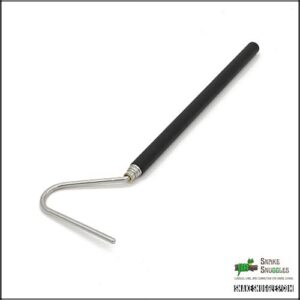
Your retractable snake handling hook becomes an essential tool when observing these fascinating carnivores and their snake feeding habits. This retractable design extends up to 39 inches, giving you safe distance while studying prey interactions or relocating snakes during feeding observations.
The stainless steel construction guarantees hook materials withstand field conditions, though some units experience handle wobble. Hook safety depends on proper handling techniques – use smooth, deliberate movements when positioning snakes for dietary behavior studies.
Here’s what makes this tool invaluable for snake diet research:
- Safe observation distance – Watch feeding behaviors without disturbing natural patterns
- Lightweight portability – Easy transport between field study sites
- Quick deployment – Rapid response when documenting hunting sequences
While unsuitable for heavy species, it excels with smaller specimens. The retractable mechanism occasionally sticks, but overall reliability makes this hook indispensable for anyone studying snake handling and feeding ecology.
Best For: Handling small snakes during dietary research and feeding observations.
Frequently Asked Questions (FAQs)
What do snakes eat?
Snakes are obligate carnivores that exclusively consume animal prey.
You’ll find them eating rodents, birds, fish, amphibians, reptiles, insects, and eggs.
Larger species tackle bigger mammals, while smaller snakes focus on invertebrates and small vertebrates, making them efficient hunters.
Do snakes eat pre-killed food?
Yes, you can feed snakes pre-killed prey. Frozen-thawed rodents are actually safer than live prey, eliminating bite risks and ensuring consistent nutrition. Most captive snakes readily accept pre-killed food.
Can snakes eat a human diet?
Over 4,100 snake species exist worldwide, yet you can’t feed them human food.
Snakes are obligate carnivores requiring whole prey like rodents, birds, or fish.
Their digestive systems can’t process plant matter, processed foods, or cooked meals that humans consume, making them reliant on whole prey.
What do omnivorous snakes eat?
There’s a common misconception here – no omnivorous snakes exist.
You’ll find that all 4,100+ snake species are strict carnivores, meaning they can’t digest plant matter at all due to their specialized digestive systems.
Why should you learn about snake diets?
Like deciphering nature’s secret recipe book, understanding snake diets reveals their ecological superpowers.
You’ll grasp how these carnivorous specialists control pest populations, maintain ecosystem balance, and contribute to biodiversity—knowledge that transforms fear into fascination.
How do snakes eat pythons?
When you’re dealing with python-eating scenarios, it’s typically other snakes doing the consuming.
King cobras and large constrictors can overpower smaller pythons using venom or constriction, then swallow them whole headfirst, which is a result of their ability to use venom or constriction.
What is the main diet of snakes?
Carnivorous creatures consume countless critters exclusively. You’ll find that snakes are strict meat-eaters, devouring mammals, birds, reptiles, amphibians, fish, and insects. Their digestive systems can’t process plants whatsoever.
What is the most common prey for snakes?
You’ll find rodents like mice and rats dominate most snake menus, offering perfect protein packages that fuel these sleek predators through weeks of digestion between meals.
What’s the biggest thing a snake has ever eaten?
You’ll be amazed – green anacondas can swallow capybaras weighing up to 130 pounds.
These South American giants stretch their jaws wide, dislocating bones to accommodate massive prey through incredible anatomical flexibility.
They are able to do this because of their massive prey.
How often do snakes eat?
You’ll typically feed your snake every 1-3 weeks, depending on its size and species.
Younger snakes eat more frequently than adults, who can comfortably go weeks between meals thanks to their efficient metabolism.
Conclusion
Understanding snake diet and prey becomes essential when you realize that some species can consume meals weighing up to 160% of their body weight.
You’ve now explored how these remarkable predators use specialized hunting strategies, anatomical adaptations, and digestive systems to thrive across diverse ecosystems.
Their opportunistic feeding behavior and flexible prey selection make them incredibly successful carnivores.
Whether you’re studying herpetology or simply curious about nature’s efficiency, remember that snake diet and prey relationships showcase evolution’s most ingenious solutions to survival challenges.
- https://www.petmd.com/reptile/nutrition/what-do-pet-snakes-eat
- https://a-z-animals.com/animals/snake/snake-facts/snakes-that-eat-other-snakes-even-rattlesnakes/
- https://phys.org/news/2018-03-reveals-snakes-strategies.html
- https://vettoday.com/blog/pet-health/how-often-do-snakes-eat/
- https://www.britannica.com/animal/snake/Specializations-for-securing-food



